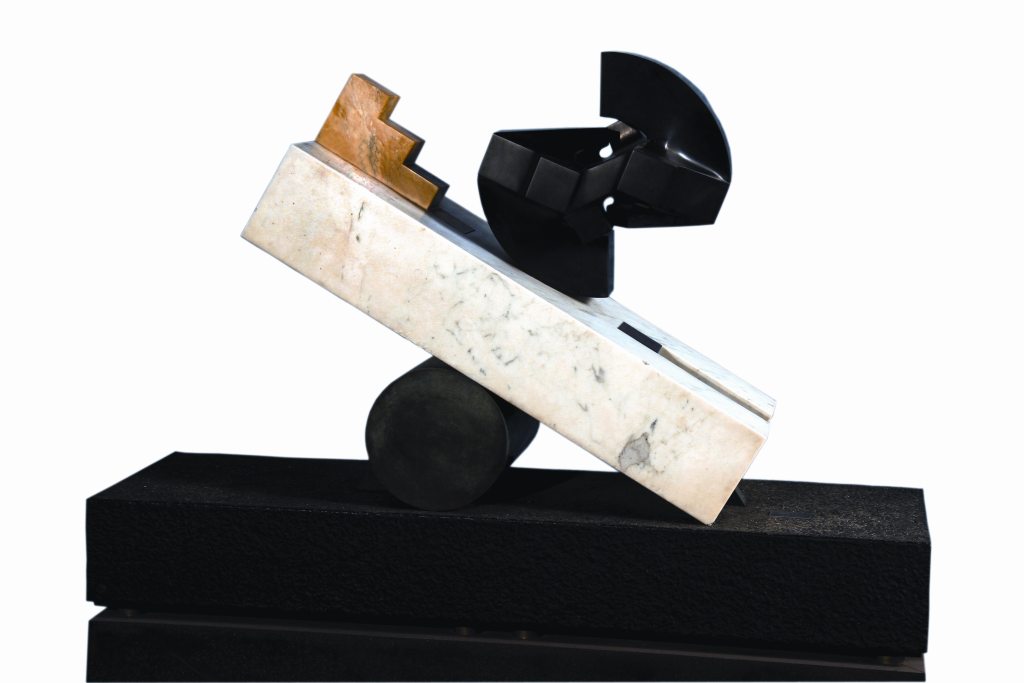GIO’ POMODORO
(Orciano di Pesaro 1930 – Milano 2002). E’ considerato uno dei più importanti scultori astrattisti a livello internazionale del XX secolo. Dal 1955 insieme al fratello Arnaldo e ad artisti di grosso calibro, si affianca ad artisti come Giulio Carlo Argan, Russoli e Guido Bazio. Più tardi si stacca da questi artisti e si dirige verso un pensiero di “rappresentazione razionale dei segni”. A questo punto si dedica attivamente alla ricerca scultorea, alla pittura, all’oreficeria d’arte, alla scenografia e al disegno. Nelle sue opere predilige grandi blocchi di marmo scolpiti che si aprono a spazi vuoti lasciando entrare la luce del sole, soggetto ricorrente nelle sue opere, anche se non è espresso esplicitamente. Nel suo paese dell’entroterra marchigiano, proprio nel luogo in cui nacque, realizzò una piazza con al centro un’opera di marmo intitolata Sole deposto con scritti alla base i versi di una celebre poesia di Leopardi.Le sue sono grandi opere monumentali in pietra e bronzo; va ricordato il complesso monumentale installato a Monza comprendente sculture in pietra del Sole-Luna al buio. Analogo al complesso di Monza è l’imponente Luogo dei punti cardinali, grande luogo creato per l’incontro e la sosta della gente. Le sue opere sono presenti in collezioni pubbliche e private in tutto il mondo.
 CARRO E SOLE
CARRO E SOLE
(1974-1986) - marmi e bronzo, cm 42x140x95
Il “Carro e Sole” rientra nel percorso di cambiamento avvenuto nell’artista negli anni ’70, quando egli trasferisce sulle sue opere il passionale impegno civile e sociale, in “ opere di ricercato stilismo neostrutturalista” utilizzando materiali come pietra e marmo. Ed è in questo ambito che si colloca il “Carro e Sole” che appartiene alla serie dei “Soli”, esposto alla mostra organizzata dalla Provincia Regionale nel 1987 in cui il concetto espresso sarebbe favorito da una ambientazione esterna. L’intersicarsi , dettato da un sistema di norme geometriche, di volumi , tra i quali il cilindro bronzeo e blocchi squadrati di marmi (nero del Belgio, giallo di Siena e bianco di Carrara) sul quale in equilibrio imposta il sole, acquista forti significativi simbolici e mitologici. Scheda Catalogo
 Giò Pomodoro - Italian sculptors at international level of the twentieth century. Since 1955, together with his brother Arnaldo and other high caliber artists, alongside artist such as Giulio Carlo Argan, Russoli and Guido Bazio. Later departs from these artists and makes for a throught of “Rational Representation of Signs”. At this point he devoted himself actively looking sculpture to painting, the goldsmith’s art, set designe and drawing. In his works he prefers large blocks of carved marble that open gaps letting in the sunlight recurring theme in his works, even if it is not expressed explicity. In his home country of the Marche’s very own in the place where he was born, made a square, with a central marble work entitled “Deposition from the sun” with the verses written at the base of a famous poem by Leopardi. His are great monumental complex installed at Monza, which includes stone sculptures of the SUN-MOON and TREES. Similar to the complex Monza is the impressive “Place of the cardinal points”, created a great place for the meeting and the rest of the people. His works are in public and private collection worldwide.
Giò Pomodoro - Italian sculptors at international level of the twentieth century. Since 1955, together with his brother Arnaldo and other high caliber artists, alongside artist such as Giulio Carlo Argan, Russoli and Guido Bazio. Later departs from these artists and makes for a throught of “Rational Representation of Signs”. At this point he devoted himself actively looking sculpture to painting, the goldsmith’s art, set designe and drawing. In his works he prefers large blocks of carved marble that open gaps letting in the sunlight recurring theme in his works, even if it is not expressed explicity. In his home country of the Marche’s very own in the place where he was born, made a square, with a central marble work entitled “Deposition from the sun” with the verses written at the base of a famous poem by Leopardi. His are great monumental complex installed at Monza, which includes stone sculptures of the SUN-MOON and TREES. Similar to the complex Monza is the impressive “Place of the cardinal points”, created a great place for the meeting and the rest of the people. His works are in public and private collection worldwide.
THE WAGON AND THE SUN - (1974-1986) - marmi e bronzo, cm 42x140x95 - The "Wagon and the Sun” falls into the path of change that occurred in the artist in the ’70 when he transfers passionate about his work on civil and social commintment in 2works of sofisticated styling neo-structuralist using materials such as stone and marble and, it is in this area that ranks “The wagon and the sun” that belongs to the series of “sun”, shown at the exhibition organized by the Province in 1987, in which the concept expressed would be favored by an outdoor setting. The intersection dictated by a sistem of rules and geometric, of volumes, including the bronze cylinder and square blocks of marble (Belgian black, yellow Siena and Carrara white) on which, in equilibrium, the sun sets thus acquiring strong symbolic and mythological.